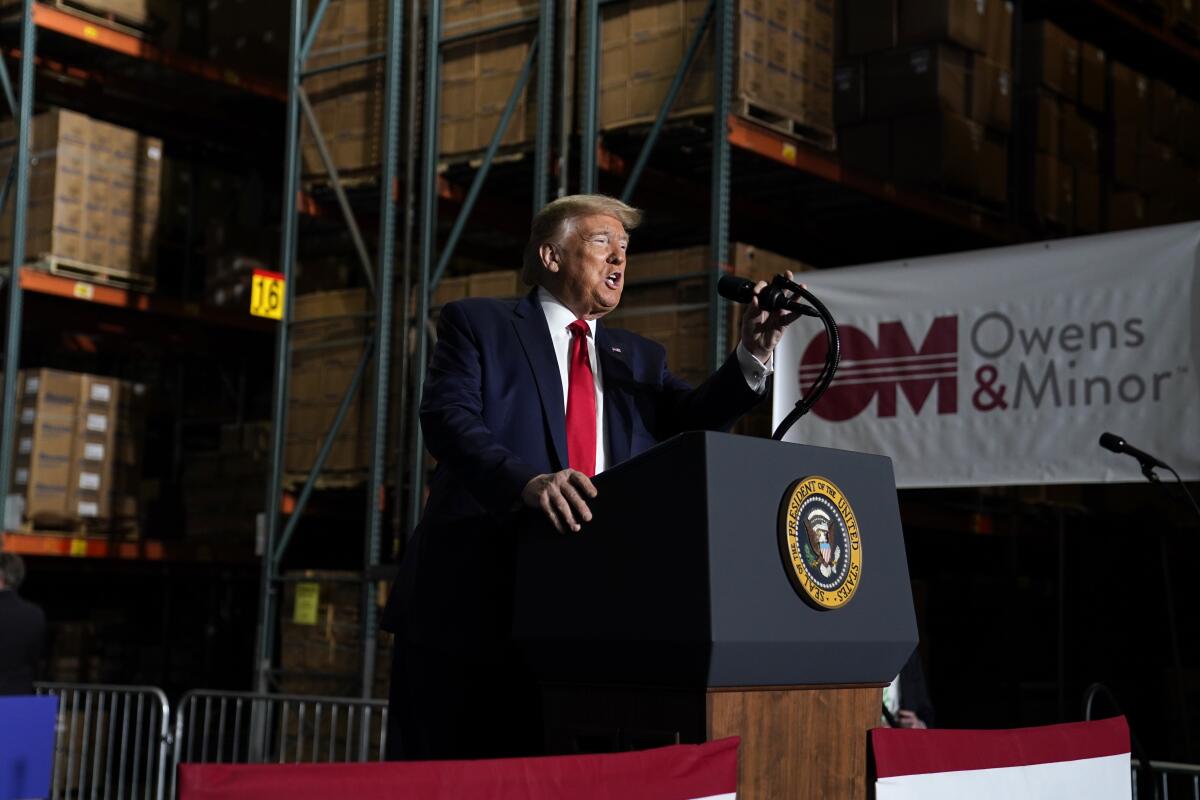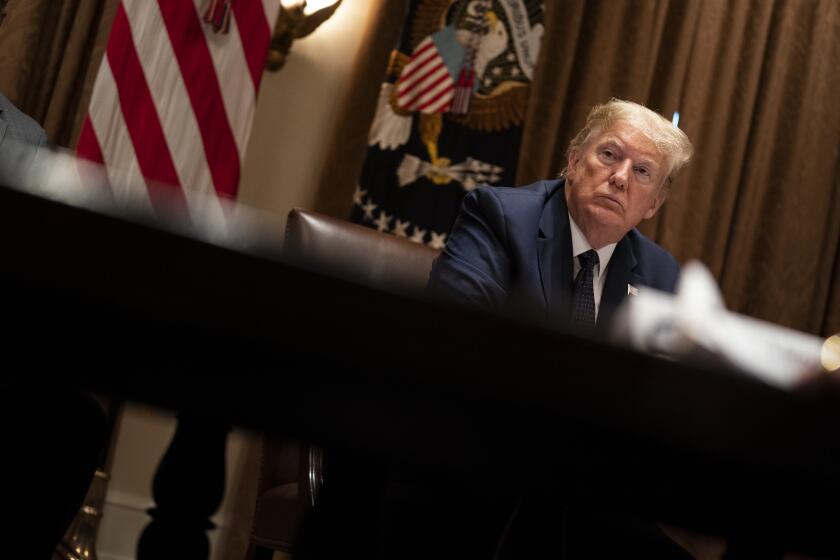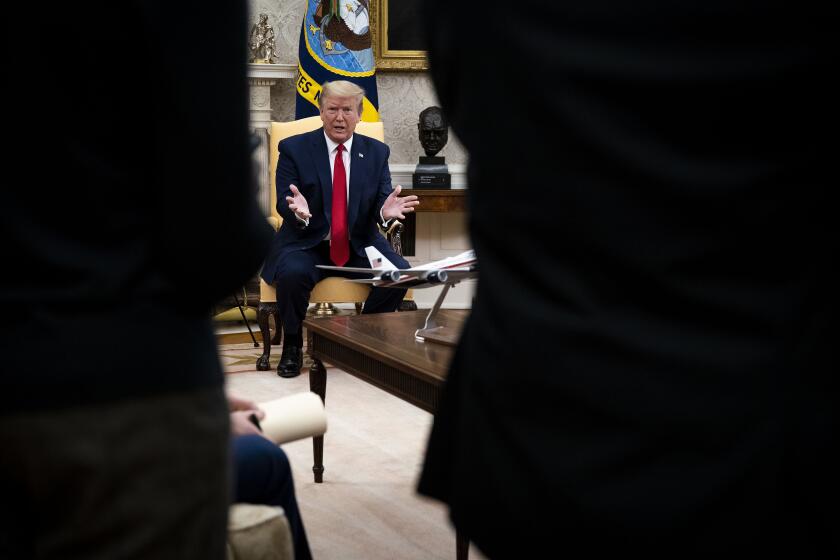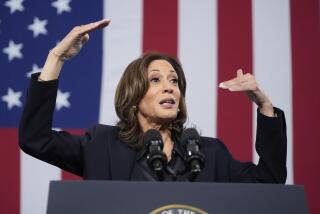Trump uses coronavirus crisis to visit swing states

- Share via
WASHINGTON — President Trump will fly to Michigan on Thursday to visit a Ford Motor Co. factory that launched a crash program last month to build ventilators and personal protective gear for the coronavirus crisis.
Last week, he visited a distribution facility in Pennsylvania that ships medical supplies around the country. And a week before that, he toured a factory in Arizona that makes respirator masks.
It’s no coincidence that Trump’s first events outside Washington since early March focused on three swing states that may determine who wins the November election.
He won all three in 2016, but polls in each state show him trailing Joe Biden, the presumptive Democratic nominee, partly due to widespread disapproval of Trump’s uneven response to the COVID-19 pandemic — including his squabbles with Democratic governors, including those in Michigan and Pennsylvania.
Ever disdainful of experts, Trump has yet to wear a protective face mask in public despite guidance from federal health authorities and the White House coronavirus task force. It’s unknown if he will don one Thursday when he tours Ford’s Rawsonville components plant in Ypsilanti, about 30 miles west of Detroit.
If he doesn’t, he’ll be in violation of Ford’s safety protocols as well as in technical violation of an executive order from Michigan Gov. Gretchen Whitmer, a frequent target of Trump’s gibes for her lockdown orders. The state has been one of the hardest hit by the coronavirus, with nearly 5,000 deaths so far.
Whitmer, who is a potential running mate for Biden, has criticized the Trump administration’s response to the outbreak. Her office said the White House had not invited her to attend Thursday’s event and that she plans to volunteer at a school that day distributing meals to children and their families.
“Every time you politicize a crisis, there’s an opportunity — but there’s also a huge risk,” said Saul Anuzis, a former Michigan GOP chairman. “That’s especially true with this crisis, because it’s affecting pretty much everyone.”
Given the federal and local resources required to coordinate and provide security for any presidential trip, the decision to travel after a catastrophic event is difficult for any White House. Doing so during a pandemic is even trickier.
“After a hurricane, you don’t want to get there and disrupt the first responders, but the waters recede after a few days,” said Thomas “Mack” McLarty, who was chief of staff to President Clinton. “This is different in that there isn’t a natural time to go.”
“But it’s important to thank first responders, doctors and nurses, to show empathy and connectivity and concern and leadership. When you have events that focus on that, they’re perfectly appropriate.”
With Trump, these taxpayer-funded events — his first two trips included short factory tours followed by roughly 30 minutes of remarks — can seem like mini-campaign appearances, with blaring music, testimonials from supporters and invective against his enemies.
At the Honeywell plant in Phoenix on May 5, Trump led an entourage in hard hats around the floor while his campaign’s festive rock ‘n’ roll playlist blasted from the speakers, infusing a moment ostensibly about hardship and sacrifice with a more celebratory air. Upon taking the stage, he started by praising his 2016 victory in Arizona.
Before Trump arrived at the Owens & Minor Inc. plant in Allentown, Pa., on May 14, multiple campaign surrogates hit local radio to promote the trip and Trump’s overall response to the pandemic.
In recent days, Trump fired another inspector general, attacked a federal judge, demeaned a whistle-blower, and slammed reporters who check his facts and performance. Instead of presidential leadership during a crisis, critics saw a deliberate campaign of disinformation and distraction.
Given his slide in the polls, Trump is increasingly anxious about his reelection effort, according to numerous aides. Karl Rove, the architect of President George W. Bush’s electoral victories in 2000 and 2004, told the president in an Oval Office meeting last week that the stalled campaign must accelerate quickly, one person familiar with the meeting said.
Trump’s unease has also led to frustrations with his campaign manager, Brad Parscale.
After a contentious discussion over internal polling weeks ago, Trump, one administration official said, was grumbling again last week after Democratic strategist James Carville referred to Parscale on TV as a “grifter,” suggesting he was getting rich running the campaign and was placating the president with “fake polls,” an assessment that appeared to hit a nerve.
“He thought he had a juggernaut campaign,” the official said. “Now there’s a lot of doubt that’s crept in.”
While Trump’s campaign and super PAC have broadcast ads in swing states attacking Biden, Democrats have countered with a barrage of spots slamming the president for failing to contain the coronavirus as successfully as have other countries.
Trump consistently boasts that the U.S. is doing more testing than any other country, but the U.S. death toll — more than 91,000 so far — is more than double that of any other nation.
Both political parties’ traditional organizing efforts in swing states remain on hold for now. But Trump’s inability to stage mass rallies arguably hurts him more since the raucous events boost his morale, energize his base and help his campaign raise money and accumulate voter data.
As he has sought to escape the confines of the White House, not to mention the sobering realities of a public-health crisis and economic calamity, Trump has shown an eagerness to return to the freewheeling, slash-and-burn tactics characteristic of campaign season, increasing his personal attacks on Democrats, the media and others.
All presidents are innately political, said Julian Zelizer, a presidential historian at Princeton University. But while, say, President Lyndon Johnson’s obsessive focus on electoral calculations was balanced to an extent by his zealous commitment to a legislative agenda, Trump’s bluntness in asserting his own self-interest above all sets him apart.
Trump’s presidency is “all about division,” Zelizer said. “Every move he makes for reelection is about just playing to his supporters and never attempting to build a broader coalition, and that’s a strategy. He sees the country as red or blue, and he focuses on red.”
Since taking office, Trump has showered attention on swing states, especially those that pushed him over the top in 2016.
In 2017, he choose an Ohio riverbank as a backdrop for a speech outlining a still-unfulfilled infrastructure plan, helped lure a Chinese iPhone manufacturer to build a new plant in Wisconsin and touted new investments in domestic auto and coal production at facilities in Michigan and Pennsylvania, respectively.
During the run-up to the midterm election in 2018, he held more than three dozen campaign rallies on behalf of Republican candidates — nearly all of them in heavily Republican, predominantly suburban and rural locales where he is most popular.
With the economy in free fall and deaths still rising from the coronavirus crisis, President Trump argued Friday that voters shouldn’t hold him responsible.
In 2016, Trump won Michigan by just 10,704 votes — a margin of 0.23% — unexpectedly dismantling Hillary Clinton’s presumed “blue wall” after also narrowly taking Wisconsin and Pennsylvania.
Four years later, the president’s allies have been pessimistic about his chances of winning Michigan in November based on weeks of internal polling data.
But according to a person involved in the reelection effort, a more recent internal poll showed Trump regaining some ground there amid growing frustration, stoked in large part by the president himself, over Whitmer’s refusal to quickly ease stay-at-home orders.
State lawmakers in Lansing last week canceled a legislative session in the face of death threats to Whitmer and the menacing presence of anti-lockdown protesters, some armed with assault rifles, at the Capitol.
“There are a lot of people in Michigan who are disenchanted with the shutdown,” said Anuzis, the former state GOP chairman. He said Trump can still galvanize the working-class white voters who backed him four years ago.
“The outbreak here was almost entirely in the urban areas, and yet we’ve got this one-size-fits-all approach that’s put a lot of people in places where there is no virus out of work,” he said. “Most people who work in manufacturing, in the automobile industry or the supply industry, they can’t work from home. So there’s an opportunity [for Trump] to take advantage of a lot of disenfranchised voters.”
More to Read
Sign up for Essential California
The most important California stories and recommendations in your inbox every morning.
You may occasionally receive promotional content from the Los Angeles Times.













